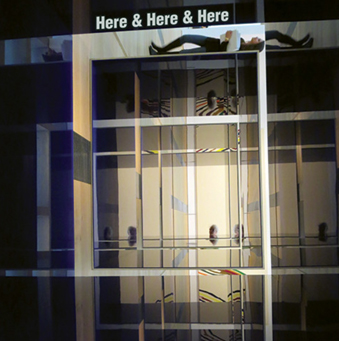The CD presents five gifted improvisers expressing a myriad of emotions thoughtfully developed and masterfully executed.
Michael Vlatkovich: trombone, percussion
Anna Homler: vocal, percussion
Jeff Kaiser: trumpet, flugelhorn
Scott Walton: acoustic bass
Rich West: drums, percussion
Recorded 1-20-14
Edited, mixed & mastered 2-4-14
at Newzone Studio in Los Angeles
Engineer: Wayne Peet
REVIEW:

Ken Waxman on Here & Here & Here, from Jazzword, December 16 , 2014
http://www.jazzword.com/one-review/?id=128640
“A spatial rather than a geographical description, the 15 tracks on this CD add up to an object lesson in how to integrate an improvising vocalist`s skills with a prime Free Music ensemble. At the same time the well-balanced and inventive program confirms that not all of California’s experimental improvisers are clustered in the Bay area.
Los Angles trumpeter Jeff Kaiser and San Diego trombonist Michael Vlatkovich have for many years waved the Free Jazz banner all over the golden state. Meanwhile LA vocalist Anna Homler has been forced to take her talents overseas to concertize with Brits like pianist Steve Beresford and violinist Sylvia Hallett. No variation of those chordal instruments is on hand here. Basically Here & Here & Here relies on the inventive pumping of bassist Scott Walton and the concentrated beats of percussionist Rich West to keep the bottom balanced as the front line works through novel sound strategies.
Committed to vocal expression that takes from vocalese, nonsense syllables, shamanistic ritual and double talk, Homler’s contributions often could be imagined as coming from a non- English-speaking-vocalist unexpectedly paired with a hip Jazz combo. At the same time though, her vocal shading, reminiscent to that of Lauren Newton and other Free Music songsters, take the place of a horn in arrangements for some tracks. With brass fully accounted for, think of Homer as a saxophonist doubling soprano and alto.
If the CD does have a drawback though, it’s the extreme brevity of some of the selections. Two minutes may be long enough for a Pop single, but with improvised music that time-span merely gives players space to suggest a concept; organic sounds like organic food take longer to nurture. Other selections which initially could develop more forcefully end up being scene-setting rather than completed creations. Popping ‘bone tones, triplet brass interludes and percussion nerve beats stand out on their own, but adds up only to a fanfare, a liquid interlude or a tone demonstration rather than a complete statement.
Much more substantial are those pieces which integrate unexpected asides within the tunes’ chromatic concepts. Textures that could arise from a kazoo, a marimba, a steel drum or a bird- caller – replicated or real – are used as color. Possessed of a Maggie Nichols-like ability to articulate nonsense syllables as if she’s singing in a legit language, on the title track Homler sweetly spins out her lines while matched by plunger trombone and guttural Jew’s harp twangs. On the other hand, as a percussion interlude clangs savagely on “Red Coda” she puts aside her reed-replication that chases timbres along with the horns for squeezed bel canto expression.
Sweetness or strength from Homler’s vocal chords and embouchure are the key variables on many of the other tunes. Growling made-up language serves its purpose when matched with trombone plunger retches or vibrated trumpet chirps, just as a lyric soprano expositions can cut through dense brass slurs to add delicacy to improvisations that could turn self-indulgent.
Overall the five players distinguish themselves as sound experimenters – and original ones at that. But next time H&H&H records, giving themselves expanded space in develop their unique expression would be beneficial for both the band and listeners.”
—Ken Waxman

